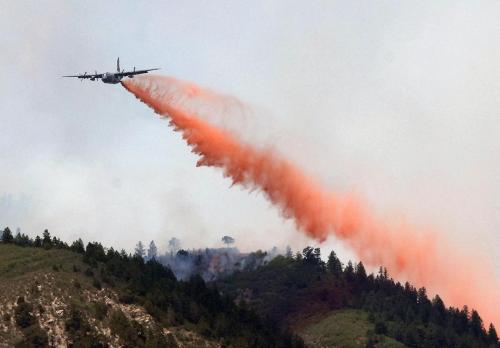MAFFS firefighting mission drops 2 millionth gallon of fire retardant for the year
Aircrews flying the C-130 Hercules aircraft equipped with the Modular Airborne Fire Fighting System dropped the 2 millionth gallon of retardant for the season.

Aircrews use a C-130 Hercules aircraft equipped with the Modular Airborne Firefighting System to drop fire retardant on a section of the Waldo Canyon fire near Colorado Springs, Colo. June 26. Aircrews flying the MAFFS mission recently dropped the 2 millionth gallon of fire retardant for the season making it the third highest in MAFFS history for gallons dropped. In 1994 about 5 million gallons were dropped and in 2000 more than 2.1 million gallons were dropped.
Crews assigned to the Air Force Reserve Command’s 302nd Airlift Wing dropped the record-breaking gallon during its third sortie of the day battling the Halstead fire north of Stanley, Idaho.
Meanwhile, the same day, the Wyoming Air National Guard's 153rd Airlift Wing also provided aerial firefighting support to the Halstead fire, and crews flew additional MAFFS-equipped C-130s in support of firefighting efforts in California and Oregon.
Officials from the 153rd Air Expeditionary Group in Boise, Idaho, said this season has become the third-highest in MAFFS history for gallons dropped, surpassed only by 1994 and 2000, when about 5 million gallons and 2.1 million gallons, respectively, were dropped.
"This has been an extremely challenging year, with several large fires and severe drought conditions," said Air Force Col. Jerry Champlin, 153rd Air Expeditionary Group commander. "Our MAFFS aircrews and aircraft maintainers have been working long hours every day to help with the initial attack and suppression of several wildland fires throughout the Western region of the country."
MAFFS-equipped C-130s have been activated since June 25, when they were requested by the U.S. Forest Service for assistance in the Rocky Mountain area. Their first missions included fire suppression support for one of the costliest fires in Colorado's history.
Throughout the 2012 season, MAFFS C-130s crews have flown out of a number of tanker base locations, moving MAFFS operations closer to the fires as needed. Tanker bases in 2012 included locations in Colorado, Wyoming, Nevada, Idaho, California, Montana and Oregon.
This year, MAFFS has supported firefighting efforts in California, Colorado, Idaho, Montana, Nevada, Oregon, South Dakota, Utah, Washington and Wyoming.
"The Air National Guard and Air Force Reserve MAFFS aircrews and support personnel have been extremely flexible, responding to short-notice changes to the MAFFS mission including tanker base relocations throughout this year," Champlin said. Through Aug. 27, the MAFFS fleet had released more than 2,152,603 gallons of fire retardant during 899 drops on fires in 10 states.
MAFFS is a joint DOD and U.S. Forest Service program designed to provide additional aerial firefighting resources when commercial and private air tankers are no longer able to meet the needs of the forest service. The system can discharge 3,000 gallons of water or fire retardant in less than five seconds, covering an area one-quarter of a mile long by 100 feet wide. Once the load is discharged, it can be refilled in less than 12 minutes.
The MAFFS-equipped C-130s are operated by four military units: the 153rd Airlift Wing, Wyoming Air National Guard; 146th Airlift Wing, California Air National Guard; 145th Airlift Wing, North Carolina Air National Guard; and the 302nd Airlift Wing, Air Force Reserve Command.
This is the first year since 2008 that all four MAFFS wings have been activated simultaneously, officials said.
Source: U.S. National Guard
- 326 reads
Human Rights
Ringing FOWPAL’s Peace Bell for the World:Nobel Peace Prize Laureates’ Visions and Actions

Protecting the World’s Cultural Diversity for a Sustainable Future

The Peace Bell Resonates at the 27th Eurasian Economic Summit

Declaration of World Day of the Power of Hope Endorsed by People in 158 Nations

Puppet Show I International Friendship Day 2020

